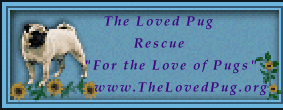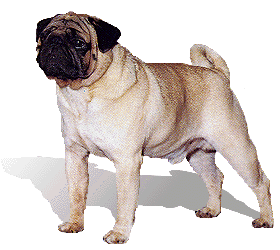


All About Pugs



All About Pugs
The care of a pug is quite minimal. They need their ears and nose wrinkles cleaned, toe nails clipped, and some may need their anal glands "expressed" periodically. While they do not need to be brushed for appearances, they do shed quite a bit and might benefit from some periodic grooming.
Pugs are NOT outdoor animals and should never be left outdoors unattended. Because of their "pushed in" face, the pug has a shorter breathing passage and is extremely susceptible to extremes of temperature, especially heat. Because of this shorter breathing passage, you must also be careful not to over exert the pug in times of warm or hot weather.
While pugs are generally good with children, small children may not be good for a pug. Because of their large, protruding eyes, they are extra susceptible to injury and must be treated gently and lovingly.
All breeds have medical problems that are often more common in the breed. Some of the ones which pugs are often plagued with are:
Elongated Soft Palate: The soft palate is part of the structure of the nose and mouth. If it is too long, it can block some of the airway to the pug's lungs and may need surgery.
Pug Dog Encephalitis (PDE): A form of encephalitis which is only seen in pugs and which is almost always fatal.
Eye Problems: Pugs are very susceptible to problems with their eyes including cataracts. Ulcers which can occur from a scratch or injury, dry eye, generalized progressive retinal atrophy, pigmentary kerinitis and other problems.
Entropian: The eyelids roll in, and the eye lashes rub on the surface of the eyes, irritating and causing scratches. If left untreated, in time this can lead to lessening of the eyesight and blindness.
Slipped Stifles (Patellar Dislocation): A dislocating kneecap can be either inherited or caused by an accident. Surgery is required if the problem is severe.
Stenotic Nares: The nostrils of the pug may be too small and/or the cartilage of the nostrils too soft for the dog to breathe through, and on inhaling they can collapse. Treatment requires surgery.
But in spite of the potential medical problems, most pug owners say that pugs are like potato chips, and you can't just have one, and once you are owned by a pug, you will probably always have one in your life!
THE UPS:
Pugs are lovable
Pugs are natural clowns
Pugs are not aggressive, as a rule
Pugs are adaptable to many situations
Pugs are great with children
Pugs are typically not big barkers
Pugs get along with almost all animals
THE DOWNS:
Pugs shed a LOT
Pugs can have health problems
Pugs can't tolerate extreme heat
Pug puppies are very active and hyper
Pugs are puppies until they are around 4 years old
Pugs should not be kept as outdoor dogs
Pugs can become overweight easily
Pugs sneeze, snort and snuffle (Prepare to clean your glasses constantly!)
Pugs snore loudly
Pugs are a member of the Toy group. They are Chinese in origin and were brought by Dutch Traders to Holland and England. They were first recognized by the AKC in 1885. Pugs were bred simply for the pleasure they bring as lap dogs. As a result, they know no greater joy than when they are with their person or family.
While they originated in China, there is no such thing as a Chinese Pug. The correct name for the breed is Pug or Pug Dog.
There are two colors of pugs, fawn, which are broken into silver and apricot fawn, and black. The fawn ones are distinguished by their black masks. Females are generally around 16-18 pounds and male pugs 18-22 pounds. Pugs do love to eat so it isn't uncommon to see them be a little bigger.
Pugs are extremely people oriented. As puppies, they are especially playful and are always underfoot for want of human companionship. The puppy stage can often last until the pug is 2 or 3 years old, and if you have another dog, the puppy will often seek out their company for play and adventure.
Pugs are smart dogs and very willing to learn, but you must show them what you want. Pugs compete in obedience and agility and have been used as therapy dogs and hearing aid dogs.
Pugs are NOT outdoor dogs and a pug should not be left alone outside. Heat and cold can easily cause death because of their "pushed in" faces.
Pugs do shed and they snort and snore. They love food and they have a great sense of humor. They are also natural clowns who will make you laugh at them. They will give you every ounce of love they have and be a true and faithful companion. A pug is anxious to please and anxious to learn. Their biggest requirement is that you love them back!